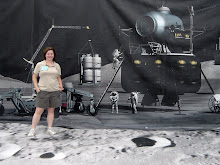Here's a comment I got recently: "We can also place a huge telescope on the moon which could replace the aging Hubble telescope. Would that not give us better resolution at greater distances? Or is this a waste of time due to the moon's orbit?" Actually, I thought this was prety obvious too, until our committee meeting a couple of weeks ago. The Moon certainly provides less atmosphere, so that's good, and the Moon's orbit is no big deal - remember that the Earth turns every 24 hours, so telescopes need to track on Earth anyway. Some people think you can get bigger collectors as well on the Moon, though a variety of techniques. But, the Moon has a lot of disadvantages too. It's still got dirt and gravity, which are inhibitors for large telescopes - gravity because you still need to build a big structure to hold and point the telescope, and dirt because it gets onto your collecting surface. Since the success of the Hubble mission, we've come to realize that there are great advantages for telescopes in free space that surpass even the Moon as the best platform. So, yes, there are some astronomy applications for which the Moon would be useful (like low-frequency radio astronomy), but for many, the advantages just aren't there. Here's a current article in Physics Today describing the pros and cons from two different points of view. The community's view on this is changing even in just the last year or two, so beware of older articles!
Another part of the comment is: "We could slowly develop mining on the moon using the iron and ore to build and launch future space missions." Well, yes and no. In-situ resource utilization (ISRU) on the Moon is a hot topic and many people are working in this area - they even holdan ISRU conference every year. One of the obvious ISRU uses is, of course, to support astronauts, bases, and continued missions. But, the Moon's resources are not like the Earth's. Here on Earth, many metals are concentrated in ore deposits. To make an ore deposit, you need a source, a transport mechanism, and a concentration mechanism or trap (hmmm, not unlike meteorites!). On Earth, by far the most common way to get these is by moving metal around in water, or less commonly, through igneous and metamorphic processes (for more, see the wiki on ore genesis). The Moon has been bone-dry since it formed and doesn't have plate tectonics, so both these major modes of ore formation are inoperable on the Moon, and there's no chance that we'll find metal deposits to mine. But, resources like oxygen and hydrogen do exist and may be able to be used to sustain humans and create rocket propellant. Read more about what the ISRU community is doing at the ISRU website.
Subscribe to:
Post Comments (Atom)

1 comment:
Riddle me this Science Girl;
Does the moon have magnetic fields? I read somewhere that one problem with putting an outpost on the moon will be shielding astronauts from radiation. Is this true?
On Earth we are shielded from much of the sun’s radiation by magnetic fields right? How will this work on the moon?
I also read that future lunar missions would be longer than the Apollo program, but that they would not run into lunar night. Does being on the surface of the moon during lunar night bring about special problems for astronauts and jet setting planetary scientists?
I hate to bring up the whole digging thing again, but what about putting in a subterranean bunker? I am just curious; after all, the new JB movie is out and "Moonraker" was one of my favorites!
Are there natural caves on the moon? What about unnatural ones?
And last but not least, my favorite three legged cat, Seven “Shifty” Jones asks the following question;
Edhbrftijojooooooooooooooooooooooooooooooooooooooofcccn nj irrrrrrrrrrrrrrrrrrrrrrrrrrrrrrrrr. 90000000000000000004ew
... ouch, a tough one, best of luck Science Girl...
-D
Post a Comment